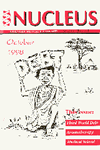Search and destroy
The Human Genome Project's aim of locating all our 100,000 genes (including those causing or predisposing to about 6,000 inherited diseases) is already well underway and should be largely fulfilled by 2004.
In the last eight years about 30 major gene companies have been launched and over 2,000 patients have received 'gene therapy'; but according to a major review in the British Medical Journal (BMJ)[2] only a handful of patients with rare conditions have so far benefited. Instead, effort is being expended in the direction of prenatal diagnosis and abortion.
Few appreciate that it is far easier to search out and destroy genetically impaired individuals than it is to correct existing genetic abnormalities. But this is the direction in which the new technology is taking us.
Prenatal diagnosis
Over 100 normal babies world-wide have now been born after pre-implantation diagnosis; a procedure which involves detection and disposal of human embryos with cystic fibrosis, Tay-Sachs disease and muscular dystrophy. In theory, any genetic disease can be detected and 'prevented' in this way. The current rate of 'treatment' in the UK is set to accelerate with two other London hospitals (in addition to the Hammersmith) recently being granted licences.[3]
Later in pregnancy 'chorion villus biopsy' can identify genetic abnormalities at eight to twelve weeks gestation and amniocentesis can be used after ultrasound and blood tests at 16 to 20 weeks.
Impact on birth rates
The major impact of these two latter technologies has been on the numbers of children being born with Down's syndrome, spina bifida and cystic fibrosis. Down's syndrome birth notifications fell from 505 in 1984 to 311 in 1993[4] while antenatal diagnosis of the condition almost doubled in the same period.[5] 92% of affected babies detected are now aborted and along with those suffering from spina bifida, made up a substantial proportion of the 94 babies 'terminated' after 24 weeks gestation in Britain in 1994. Cystic fibrosis is a much rarer condition, but in Edinburgh where antenatal screening is routine, the average number of births of children with the disease have fallen from 4.6 to 1.6 per year.[6
Spreading acceptance
While the practice did briefly feature on the national news in 1995 (largely as a result of the wife of the editor of the Spectator giving birth to a Down's Syndrome child)[7] there has been very little discussion of the ethics in the medical press. A BMJ article[8] advocating abortion as a means of reducing congenital abnormalities by 90% sparked only two letters of protest.[9]
Instead most discussion focuses on finding the most 'cost-effective' means of discovering and disposing of genetically abnormal individuals. 'Research' has suggested, for example, that it costs £80,000 to detect and abort one Down's baby and £120,000 to cover a lifetime's cost of care.[10]
Although the risk of Down's Syndrome increases with maternal age, over 70% of affected pregnancies occur in women under 35.[11] This has prompted recent calls for the establishment of 35 further screening centres in Britain with the tests being offered to all pregnant women.[12] If implemented, this would lead to the virtual eradication of Down's Syndrome and such a move would be legal in Britain under the 1967 Abortion Act and amendments to it in the 1991 Human Fertilisation & Embryology Act.
What we are witnessing is no less than the politicisation of Darwinism. The non-survival of the weakest is becoming established as a public duty.
A clash of ethics
The Judaeo-Christian ethic (whereby the strong make sacrifices for the weak) has been replaced by an 'evolutionary' ethic (whereby the weak are sacrificed in the interests of the strong).
This 'survival of the fittest' mentality is contrary to the general strategy of medicine. Medicine has always striven to overturn, rather than to duplicate the natural order, and it is this that has resulted in the advances which have revolutionised survival in some conditions and improved quality of life in many others.
Better solutions
The supreme irony is that antenatal 'search and destroy' is taking place at a time when the management of previously untreatable or unpreventable conditions is advancing faster than ever before.
One dramatic example of this is in neonatal (and even prenatal) surgery for congenital abnormalities. Another is that giving dietary supplements of folic acid to women of child-bearing age can halve the incidence of neural tube defects (such as spina bifida). The life expectancy of cystic fibrosis patients has doubled in recent years along with a vast improvement in quality of life, and support services for children with Down's Syndrome have never been better. None of these events would have occurred if doctors had been offered the 'easy way out'.
Prenatal screening alone is problematic. Many screening methods are inaccurate and the screening process itself can cause psychological damage to pregnant women.[13] But the move to 'search and destroy' is an outrage. It devalues handicapped people, many of whom lead useful and fulfilling lives; it also means that more and more funds are being channelled from therapeutic to eugenic research.
We should not minimise the considerable physical, financial and psychological cost of raising children with special needs, but nevertheless the way we treat the most vulnerable members of our community speaks volumes about the sort of society that we are. 'Bearing one another's burdens' is the very heart of the 'the law of Christ' (Gal 6:2).
































